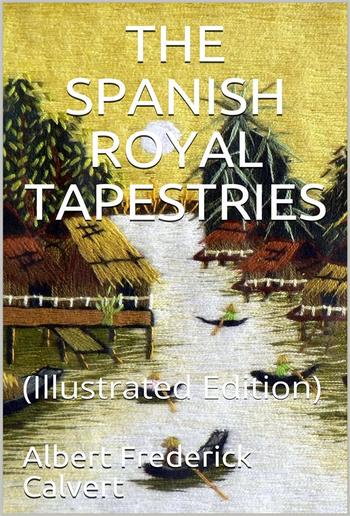
Albert Frederick Calvert - The Spanish Royal Tapestries
The Spanish Royal Tapestries
(Illustrated Edition)
Albert Frederick Calvert
Description
Contents
History of the art of tapestry weaving -- The foundation of the Spanish royal collection -- The Gothic tapestries -- Tapestries of the Gothic-Renaissance transition -- Renaissance tapestries.
Tapestry is a form of textile art, traditionally woven by hand on a loom. Tapestry is weft-faced weaving, in which all the warp threads are hidden in the completed work, unlike cloth weaving where both the warp and the weft threads may be visible. In tapestry weaving, weft yarns are typically discontinuous; the artisan interlaces each coloured weft back and forth in its own small pattern area. It is a plain weft-faced weave having weft threads of different colors worked over portions of the warp to form the design.
Most weavers use a natural warp thread, such as wool, linen or cotton. The weft threads are usually wool or cotton but may include silk, gold, silver, or other alternatives.
The success of decorative tapestry can be partially explained by its portability (Le Corbusier once called tapestries "nomadic murals"). Kings and noblemen could roll up and transport tapestries from one residence to another. In churches, they were displayed on special occasions. Tapestries were also draped on the walls of castles for insulation during winter, as well as for decorative display.
Tapestries have been used since at least Hellenistic times. Samples of Greek tapestry have been found preserved in the desert of Tarim Basin dating from the 3rd century BC.
The form reached a new stage in Europe in the early 14th century AD. The first wave of production occurred in Germany and Switzerland. Over time, the craft expanded to France and the Netherlands. The basic tools have remained much the same.
In the 14th and 15th centuries, Arras, France was a thriving textile town. The industry specialised in fine wool tapestries which were sold to decorate palaces and castles all over Europe. Few of these tapestries survived the French Revolution as hundreds were burnt to recover the gold thread that was often woven into them. "Arras" is still used to refer to a rich tapestry no matter where it was woven. Indeed, as literary scholar Rebecca Olson argues, Arras were the most valuable objects in England during the early modern period and inspired writers such as William Shakespeare and Edmund Spenser to weave these tapestries into their most important works such as Hamlet and The Faerie Queene.

